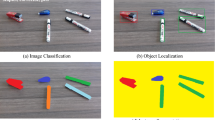Abstract
This paper proposes an algorithm that preserves objects in Markov Random Fields (MRF) region growing based image segmentation. This is achieved by modifying the MRF energy minimization process so that it would penalize merging regions that have real edges in the boundary between them. Experimental results show that the integration of edge information increases the precision of the segmentation by ensuring the conservation of the objects contours during the region-growing process.






Similar content being viewed by others
References
Yu Q, Clausi DA (2008) IRGS: image segmentation using edge penalties and region growing. IEEE Trans Pattern Anal Mach Intell 30:2126–2139
Otsu N (1979) A threshold selection method from gray-level histograms. IEEE Trans Syst Man Cybern 9:62–66
Jain AK, Dubes RC (1988) Algorithms for clustering data. Prentice Hall, New Jersey
Ma WY, Manjunath BS (2000) Edgeflow: a technique for boundary detection and image segmentation. IEEE Trans Image Process 9(8):1375–1388
Nguyen HT, Worring M, van den Boomgaard R (2003) Watersnakes: energy-driven watershed segmentation. IEEE Trans Pattern Anal Mach Intell 25(3): 330–342
Vincent L, Soille P (1991) Watershed in digital spaces: an efficient algorithm based on immersion simulations. IEEE Trans Pattern Anal Mach Intell 13(6):583–598
Adams R, Bischof L (1994) Seeded region growing. IEEE Trans Pattern Anal Mach Intell 16(6):641–647
Haris K, Efstratiadis SN, Maglaveras N, Katsaggelos AK (1998) Hybrid image segmentation using watersheds and fast region merging. IEEE Trans Image Process 7(12):1684–1699
Cootes TF, Taylor CJ, Cooper DH, Graham J (1995) Active shape models—their training and application. Comp Vis Image Underst 61(1):38–59
Kass M, Witkin A, Terzopoulos D (1987) Snakes: active contour models. Int’l J Comp Vis 1(4):321–331
Yezzi JA, Tsai A, Willsky A (2002) A fully global approach to image segmentation via coupled curve evolution equations. J Vis Commun Image Represent 13:195–216
Derin H, Elliott H (1987) Modeling and segmentation of noisy and textured images using Gibbs random fields. IEEE Trans Pattern Anal Mach Intell 9(1):39–55
Geman S, Geman D (1984) Stochastic relaxation, Gibbs distributions, and the Bayesian restoration of images. IEEE Trans Pattern Anal Mach Intell 6(6):721–741
Kumar S, Hebert M (2006) Discriminative Random Fields. Int’l J Comp Vis 68(2):179–202
Won CS, Derin H (1992) Unsupervised segmentation of noisy and textured images using Markov Random Fields. CVGIP: Graph Models Image Process 54(4):308–328
Besag J (1986) On the statistical analysis of dirty pictures. J Roy Stat Soc B 48(3):259–302
Andrey P, Tarroux P (1998) Unsupervised segmentation of Markov Random Field modeled textured images using selectionist relaxation. IEEE Trans Pattern Anal Mach Intell 20(3):252–262
Zhang J (1992) The mean field theory in EM procedures for Markov Random Fields. IEEE Trans Signal Process 40(10):2570–2583
Cheng L, Caelli T (2003) Unsupervised image segmentation: a Bayesian approach. In: Proceedings of 16th international conference on vision interface, Halifax, Canada, pp 251–257
Boykov Y, Veksler O, Zabih R (2001) Fast approximate energy minimization via graph cuts. IEEE Trans Pattern Anal Mach Intell 23(11):1222–1239
Li SZ (2001) Markov Random Field modeling in image analysis. Springer, London
Meyer, Fernand (1994) “Topographic distance and watershed lines,” vol. 38 Signal Process, pp 113–125
Canny FJ (1986) A computational approach to edge detection. IEEE Trans Pattern Anal Mach Intell 8(6):679–698
Author information
Authors and Affiliations
Corresponding author
Rights and permissions
About this article
Cite this article
Dawoud, A., Netchaev, A. Preserving objects in Markov Random Fields region growing image segmentation. Pattern Anal Applic 15, 155–161 (2012). https://doi.org/10.1007/s10044-011-0198-x
Received:
Accepted:
Published:
Issue Date:
DOI: https://doi.org/10.1007/s10044-011-0198-x




